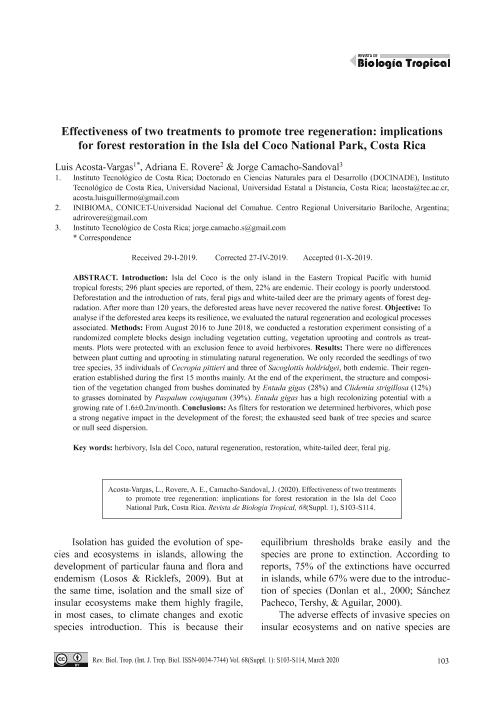Mostrar el registro sencillo del ítem
dc.contributor.author
Acosta Vargas, Luis
dc.contributor.author
Rovere, Adriana

dc.contributor.author
Camacho Sandoval, Jorge
dc.date.available
2023-01-09T18:41:02Z
dc.date.issued
2020-03
dc.identifier.citation
Acosta Vargas, Luis; Rovere, Adriana; Camacho Sandoval, Jorge; Effectiveness of two treatments to promote tree regeneration: Implications for forest restoration in the Isla del Coco National Park, Costa Rica; Universidad de Costa Rica; Revista de Biología Tropical; 68; S1; 3-2020; 103-114
dc.identifier.issn
0034-7744
dc.identifier.uri
http://hdl.handle.net/11336/183994
dc.description.abstract
Introduction: Isla del Coco is the only island in the Eastern Tropical Pacific with humid tropical forests; 296 plant species are reported, of them, 22% are endemic. Their ecology is poorly understood. Deforestation and the introduction of rats, feral pigs and white-tailed deer are the primary agents of forest deg-radation. After more than 120 years, the deforested areas have never recovered the native forest. Objective: To analyse if the deforested area keeps its resilience, we evaluated the natural regeneration and ecological processes associated. Methods: From August 2016 to June 2018, we conducted a restoration experiment consisting of a randomized complete blocks design including vegetation cutting, vegetation uprooting and controls as treat-ments. Plots were protected with an exclusion fence to avoid herbivores. Results: There were no differences between plant cutting and uprooting in stimulating natural regeneration. We only recorded the seedlings of two tree species, 35 individuals of Cecropia pittieri and three of Sacoglottis holdridgei, both endemic. Their regeneration established during the first 15 months mainly. At the end of the experiment, the structure and composition of the vegetation changed from bushes dominated by Entada gigas (28%) and Clidemia strigillosa (12%) to grasses dominated by Paspalum conjugatum (39%). Entada gigas has a high recolonizing potential with a growing rate of 1.6±0.2m/month. Conclusions: As filters for restoration we determined herbivores, which pose a strong negative impact in the development of the forest; the exhausted seed bank of tree species and scarce or null seed dispersion.
dc.description.abstract
Introducción: Isla del Coco es la única isla en el Pacífico oriental con bosques tropicales húmedos, albergando 296 especies de plantas, de las cuales un 22% son endémicas. De su ecología se conoce muy poco. El bosque fue degradado con la introducción de cerdos y venados cola blanca y por deforestación. Las áreas deforestadas hace más de 120 años nunca recuperaron el bosque nativo. Objetivo: Para analizar si el área deforestada mantiene su capacidad de recuperación, se evaluó la regeneración natural y los procesos ecológicos asociados. Metodología: Desde agosto de 2016 hasta junio de 2018, se monitoreó un ensayo de restauración, establecido como un diseño de bloques completos al azar. Los tratamientos incluyeron corte de vegetación, arranque de vegetación y controles. Se utilizó una cerca de exclusión para evitar los herbívoros. Resultados: No hubo diferencias en los tratamientos de corte y arranque de la vegetación para estimular la regeneración natural. Se registró la regeneración de dos especies de árboles: 35 individuos de Cecropia pittieri y tres de Sacoglottis holdridgei, ambas endémicas. La regeneración se estableció principalmente en los primeros 15 meses. Luego de aplicados los tratamientos, la estructura y composición de la vegetación cambió de arbustos dominados por Entada gigas (28%) y Clidemia strigillosa (12%), a pastos dominados por Paspalum conjugatum (39%). Entada gigas tiene el mayor potencial de recolonización por su tasa de crecimiento de 1.6±0.2m/mes. Conclusiones: Los filtros determinados asociados con la regeneración del bosque son los herbívoros; el banco de semillas de las especies arbóreas agotado y la dispersión de semillas escasa o nula, según la especie.
dc.format
application/pdf
dc.language.iso
eng
dc.publisher
Universidad de Costa Rica
dc.rights
info:eu-repo/semantics/openAccess
dc.rights.uri
https://creativecommons.org/licenses/by/2.5/ar/
dc.subject
FERAL PIG
dc.subject
HERBIVORY
dc.subject
ISLA DEL COCO
dc.subject
NATURAL REGENERATION
dc.subject
RESTORATION
dc.subject
WHITE-TAILED DEER
dc.subject.classification
Otras Ingeniería del Medio Ambiente

dc.subject.classification
Ingeniería del Medio Ambiente

dc.subject.classification
INGENIERÍAS Y TECNOLOGÍAS

dc.title
Effectiveness of two treatments to promote tree regeneration: Implications for forest restoration in the Isla del Coco National Park, Costa Rica
dc.title
Efectividad de dos tratamientos para promover la regeneración de árboles: Implicaciones para la restauración de bosques en el Parque Nacional Isla del Coco
dc.type
info:eu-repo/semantics/article
dc.type
info:ar-repo/semantics/artículo
dc.type
info:eu-repo/semantics/publishedVersion
dc.date.updated
2021-09-06T20:30:00Z
dc.identifier.eissn
2215-2075
dc.journal.volume
68
dc.journal.number
S1
dc.journal.pagination
103-114
dc.journal.pais
Costa Rica

dc.journal.ciudad
San José de Costa Rica
dc.description.fil
Fil: Acosta Vargas, Luis. Instituto Tecnológico de Costa Rica; Costa Rica
dc.description.fil
Fil: Rovere, Adriana. Consejo Nacional de Investigaciones Científicas y Técnicas. Centro Científico Tecnológico Conicet - Patagonia Norte. Instituto de Investigaciones en Biodiversidad y Medioambiente. Universidad Nacional del Comahue. Centro Regional Universidad Bariloche. Instituto de Investigaciones en Biodiversidad y Medioambiente; Argentina
dc.description.fil
Fil: Camacho Sandoval, Jorge. Instituto Tecnológico de Costa Rica; Costa Rica
dc.journal.title
Revista de Biología Tropical

dc.relation.alternativeid
info:eu-repo/semantics/altIdentifier/url/https://revistas.ucr.ac.cr/index.php/rbt/article/view/41172
dc.relation.alternativeid
info:eu-repo/semantics/altIdentifier/doi/https://doi.org/10.15517/rbt.v68iS1.41172
dc.relation.alternativeid
info:eu-repo/semantics/altIdentifier/url/https://www.scielo.sa.cr/scielo.php?script=sci_arttext&pid=S0034-77442020000500103&lng=en&nrm=iso&tlng=en
Archivos asociados
